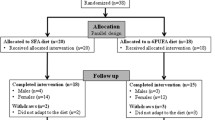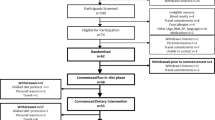Summary.
Dietary fatty acids are incorporated into atheromatous plaques mainly in the form of cholesterol esters. Physicochemical properties of the plaque (e. g. mechanical strength) depend on its fatty acid composition. Trans isomers of unsaturated fatty acids (TFA) are known to reduce the availability of fatty acid precursors for the synthesis of anticoagulant PG1 and PG3 prostaglandins.
The present study was undertaken to determine the content of trans isomers in atheromatous plaques and to search for correlations between trans isomers in the plaque and adipose tissue. Atheromatous plaques were obtained from 31 patients who underwent surgery due to atherosclerotic stenosis of the abdominal aorta, iliac or femoral arteries. Fatty acids were extracted and separated as methyl esters using gas chromatography (GC) with an internal standard. Correlations were searched for with statistical methods, taking the level of significance as p < 0.05.
We found spatial and positional isomers of sixteen- and eighteen-carbon fatty acids in plaques and adipose tissue, with elaidic acid (C18:1 trans-9) being the most abundant. Every plaque and adipose tissue sample contained linolelaidic acid (C18:2 trans-9 trans-12) which is derived exclusively from linoleic acid, as well as conjugated dienes of linoleic acid (CLA) produced during oxidative processes. The presence of trans isomers of fatty acids in the atheromatous plaque seems to be of relevance to plaque formation. Of much concern is the detection of elaidic and linolelaidic acids which adversely affect the physiologically important metabolism of eicosanoids. The TFA pool in adipose tissue has little effect on the amount of these acids in the atheromatous plaque. Apparently, the presence of TFA in atheromatous plaques is the result of processes taking place during plaque formation and maturation.
Similar content being viewed by others
Abbreviations
- BMI:
-
body mass index
- BHT:
-
butylated hydroxytoluene
- CLA:
-
conjugated dienes of linoleic acid
- IHD:
-
ischemic heart disease
- HDL:
-
high density lipoprotein
- LDL:
-
low density lipoprotein
- MUFA:
-
monounsaturated fatty acids
- PUFA:
-
polyunsaturated fatty acids
- SFA:
-
saturated fatty acids
- TLC:
-
thin layer chromatography
- TFA:
-
trans fatty acids
- TG:
-
triacylglycerols
References
Slover HT, Thompson JR, Davis CS, Merola GV (1985) Lipids in margarines and margarine-like foods. J Am Oil Chem Soc 62:775–786
Zock PL, Katan MB (1997) Butter, margarine and serum lipoproteins. Atherosclerosis 131:7–16
Judd JT, Baer DJ, Clevidence BA, Muesing RA, Chen SC, Weststrate JA, Meijer GW, Wittes J, Lichtenstein AH, Villela-Bach M, Schaefer EJ (1998) Effects of margarine compared with those of butter on blood lipid profiles related to cardiovascular disease risk factors in normolipemic adults fed controlled diets. Am J Clin Nutr 68:768–777
Willett WC, Stampfer MJ, Manson JE, Colditz GA, Speizer FE, Rosner BA, Sampsson LA, Hennekens CHH (1993) Intake of trans fatty acids and risk of coronary heart disease among women. Lancet 34:581–585
Aro A, Kardinaal AFM, Salminen I, Kark JD, Riemersma RA, Delgado-Rodriguez M, Gomez-Aracena J, Huttuenen JK, Kohlemer L, Martin BC, Martin-Moreno JM, Mazaev VP, Ringstad J, Thamm M, van’t Veer P, Kok FJ (1995) Adipose tissue isomeric trans fatty acids and risk of myocardial infarction in nine countries: the Euramic study. Lancet 345:273–278
Ascheiro A, Hennekens CHH, Burning JE, Master C, Stampfer MJ, Willett WC (1994) Trans fatty acids intake and risk of myocardial infarction. Circulation 89:94–101
van der Vijver LP, Kardinaal AF, Couet C, Aro A, Kafatos A, Steingrimsdottir L, Amorim Cruz JA, Moreiras O, Becker W, van Amelsvoort JMM, Vidal-Jessel S, Salaminen I, Moschandreas J, Sigfusson N, Martins I, Carbajal A, Ytterfors A, van Poppel G (2000) Association between trans fatty acid and cardiovascular risk factors in Europe: the Transfair study. Eur J Clin Nutr 54:126–135
Kummerow FA, Zhou Q, Mahfouz MM (1999) Effect of trans fatty acids on calcium influx into human arterial endothelial cells. Am J Clin Nutr 70:832–838
Lawson LD, Hill EG, Holman RT (1983) Suppression of arachidonic acid in lipids of rat tissues by dietary mixed isomeric cis and trans octadecenoates. J Nutr 113:1827–1835
Cook H, Emken EA (1990) Geometric and positional fatty acid isomers interact differently with desaturation and elongation of linoleic and linolenic acids in cultured glioma cells. Biochem Cell Biol 68:653–660
Jones D (1993) Trans fatty acids and dieting. Lancet 341:1093
Felton CV, Crook D, Davies MJ, Oliver MF (1994) Dietary polyunsaturated fatty acids and composition of human aortic plaques. Lancet 344:1195–1196
Allain CC, Poon LS, Chang GSC, Richmond W, Fu PC (1974) Enzymatic determination of total serum cholesterol. Clin Chem 20:470–475
Bucolo G, David H (1973) Quantitative determination of serum triglycerides by use of enzymes. Clin Chem 19:476–482
Grove TH (1979) Effect of reagent pH on determination of high-density lipoprotein cholesterol by precipitation with sodium phosphotungstate-magnesium. Clin Chem 25:560–564
Friedewald WT, Levy RI, Fredrickson DS (1972) Estimation of the concentration of low-density lipoprotein cholesterol in plasma without use of preparative ultracentrifuge. Clin Chem 18:499–502
Folch J, Lees M, Stanley Sloane V (1957) A simple method for the isolation and purification of total lipids from animal tissues. J Biol Chem 226:497–509
Ulberth F, Henninger M (1992) Simplified method for the determination of trans monoenes in edible fats by TLGGLC. JAOCS 69:829–831
Hudgins LC, Hirsch J, Emken EA (1991) Correlation of isomeric fatty acids in human adipose tissue with clinical risk factors for cardiovascular disease. Am J Clin Nutr 53:474–482
Felton CV, Crook D, Davies MJ, Oliver MF (1993) Lipid and fatty acid distribution in nonulcerated and ulcerated human aortic plaques. J Vasc Med Biol 4:228–234
Katz AM (2002) Trans-fatty acids and sudden cardiac death. Circulation 105:669–671
Lemaitre RN, King IB, Raghunathan TE, Pearce RM, Weinmann S, Knopp RH, Copass MK, Cobb LA, Siscovick DS (2002) Cell membrane trans fatty acid and the risk of primary cardiac arrest. Circulation 105:697–701
Katan MB (2000) Trans fatty acids and plasma lipoproteins. Nutr Rev 58:188–191
Sebedio JL, Vermunt S H, Chardigny JM, Beaufrere B, Mensink RP, Armstrong RA, Christie WW, Niemela J, Henon G, Riemersma RA (2000) The effect of dietary trans alpha-linolenic acid on plasma lipids and platelet fatty acid composition: the TransLinE study. Eur J Clin Nutr 54:104–113
Bartnikowska E (2000) Can CLA be regarded as a nutraceutical? Pol J Food Nutr Sci 35:55–59
Gurr MI (1990) Trans fatty acids and health—an update. Lipid Technology 2:105–107
Abbey M, Nestel PJ (1994) Plasma cholesterol ester transfer protein activity is increased when trans-elaidic acid is substituted for cis-oleic acid in the diet. Atherosclerosis 106:99–107
Katan MB, Zock PL, Mensik RP (1995) Trans fatty acids and their effect on lipoprotein in humans. Ann Rev Nutr 15:473–793
Pariza MW, Park Y, Cook ME (2000) Mechanisms of action of conjugated linoleic acid: evidence and speculation. Proc Soc Exp Biol Med 223:8–13
Dormandi TL,Wickens DG (1987) The experimental and clinical pathology of diene conjugation. Chem Phys Lipids 45:353–364
Adlof RO, Duval S, Emken EA (2000) Biosynthesis of conjugated linoleic acid in humans. Lipids 35:131–135
Kinsella JE, Bruckner G, Mai J, Shimp J (1981) Metabolism of trans fatty acids with emphasis on the effect of trans, trans-octadecadienoate on lipid composition, essential fatty acid and prostaglandins: an overview. Am J Clin Nutr 43:2307–2318
Author information
Authors and Affiliations
Corresponding author
Rights and permissions
About this article
Cite this article
Stachowska, E., Dołęgowska, B., Chlubek, D. et al. Dietary trans fatty acids and composition of human atheromatous plaques. Eur J Nutr 43, 313–318 (2004). https://doi.org/10.1007/s00394-004-0479-x
Received:
Accepted:
Published:
Issue Date:
DOI: https://doi.org/10.1007/s00394-004-0479-x




